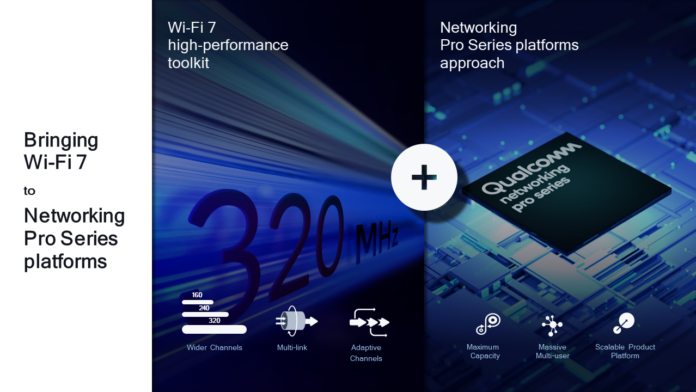Qualcomm announced its Wi-Fi 7 Pro Series portfolio this week, highlighting the importance of features like 320 MHz channel support, 4K QAM and Multi-Link capabilities.
The chipmaker’s senior vice president and general manager of Wireless Infrastructure and Networking Nick Kucharewski, shared what to expect with its latest generation of solutions, but also outlined three areas that differentiate its broader Wi-Fi portfolio.
“Number one is maximum capacity,” he told RCR Wireless News. “This means that the highest possible chain count, the highest number of bands, the highest amount of aggregate PHY rate. Number two [is] maximum multi-user scale. In the last two generations, we support 500 clients connected on any one band on the platform.”
The third, and according to Kucharewski, perhaps the most important, differentiator is the company’s commitment to a modular architecture. “We don’t focus on developing a single chipset or chip; rather we envision a full set of products that our customers can bring to market, touching on multiple different cost points and regions to enable our customers to develop a full line of products with a single software investment,” he explained, adding that you can expect that theme to continue into the company’s Wi-Fi 7 launch.
This last point about modularity has only become more critical as Wi-Fi has evolved. Kucharewski said that the need for modular architectures really began with Wi-Fi 6 as it became clear that a “one-size-fits-all” approach to Wi-Fi connectivity was no longer going to work.
“I think there are a couple of reasons for that. One was the advent of mesh networking, which changes things a lot. It went from having a single router — and the only question being ‘do you have a big house or a small house?’ — to there being [several] different ways of providing connectivity,” Kucharewski provided.
He added that Qualcomm encourages its customers to develop differentiated ways of providing connectivity but acknowledged that is means the chipmakers must support a wide range of form factors. “That is something we were supporting a bit prior to Wi-Fi 6, but we really took a disciplined approach to that all the way through our design process. We have been emphasizing that with every generation,” he said.
Beyond the supporting the features mentioned above and establishing new performance benchmarks in wireless networking of up to 33 Gbps wireless interface capacity and peak throughputs over 10 Gbps, Qualcomm’s Wi-Fi 7 series will also benefit from Automated Frequency Coordination (AFC). To avoid potential interference with existing 6 GHz incumbents, the Federal Communications Commission (FCC) the Federal Communications Commission (FCC) established AFC, a spectrum use coordination system designed specifically for 6 GHz operation that resembles similar systems in place such as the one that supports CBRS wireless operation.
During a different conversation with RCR Wireless News, Kucharewski provider further insight: “The situation is that there are other devices currently using that 6 GHz spectrum. In order for Wi-Fi devices to participate, you need to check and see whether there is an incumbent device operating in the same band. If there is, you have to limit your output power of the device. But if there [isn’t], you can […] operate at a higher transmit power, which means you get longer range and higher performance.”
However, for this coordination to occur, software must be built into the router and a cloud service is needed to tell the device that it can operator in the 6 GHz spectrum. As a result, Qualcomm developed an end-to-end, turnkey AFC service for hardware and software. This way, explained Kucharewski, when the FCC enables the AFC standard, Qualcomm customers will already have an implemented AFC solution that can be taken to the FCC for end-to-end certification. “That should allow them to move more quickly,” he added.
For Kucharewski, Wi-Fi 7 adoption won’t look too different from Wi-Fi 6 adoption, with products beginning to hit the market early next year and with first volume shipments limited to the higher performance tiers.
“For the first several years, we see Wi-Fi 6 and 7 coexisting and then overtime, you’ll see more compact form factors,” he predicted.

